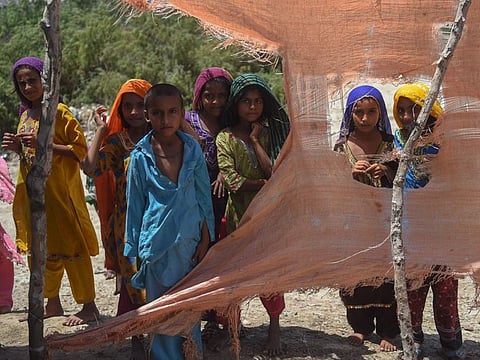Pakistan to evacuate 100,000 people as Cyclone Biparjoy approaches
37,000 relocated, more evacuations under way in coastal areas of Sindh province

Islamabad: Pakistani authorities have initiated a massive evacuation effort, aiming to relocate around 100,000 people in coastal towns and villages of Sindh province as Cyclone Biparjoy approaches the country’s southern coast.
The powerful cyclonic storm is likely to make a landfall between Keti Bandar in Pakistan’s Sindh province and the Indian state of Gujarat on Thursday, the Pakistan Met Office said.
Lt Gen Inam Haider Malik, the chief of Pakistan’s National Disaster Management Authority (NDMA), emphasized the urgency of the evacuation efforts. During a press conference held alongside the country’s climate change minister on Tuesday, Malik stated, that “there are close to 100,000 people who need to be evacuated” from vulnerable areas. He said that the evacuation process would be swiftly completed by Thursday (June 15) morning.
More than 37,000 individuals or 778 families have already been evacuated from coastal areas by June 13 afternoon. Of which 24,105 evacuations were completed by the government while the remaining had voluntarily moved to safer locations, according to an update shared by Sindh Information Minister Sharjeel Inam Memon. Another 10,000 are expected to be relocated by late Tuesday. Mandatory evacuation orders have been issued for the residents of the coastal towns and villages in the Thatta, Badin, and Sajawal districts of Sindh province, which are most likely to be affected by the cyclone’s impact.
Don’t panic but be prepared
As the cyclone progresses, the government is taking precautionary measures to ensure the safety of its citizens and mitigate risks. Climate Change Minister Sherry Rehman said that it was important to take precautionary measures. “Without panicking, people need to take PDMA advisories seriously … [The Cyclone] is highly unpredictable so please do not take it casually. It is varying in intensity but caution is crucial, especially near the Sindh coast.”
She highlighted the risks associated with the cyclone, saying that “The coastline is at high risk and waves between eight to 12 feet can hit the shores,” as the speed of the cyclone was 200km per hour. She cautioned that the port city of Karachi could experience urban flooding due to the intensity of the storm. “Karachi will likely face urban flooding given the scale and intensity of winds and expected heavy rains.
Anticipated consequences of the cyclone include heavy rainfall, thunderstorms, and high winds across south and southeast Sindh, including Karachi, Thatta, Sujawal, Badin, Tharparkar, and Mirpurkhas, during June 13-17. Karachi is expected to receive 113mm of rainfall, while Thatta is projected to experience over 300mm of precipitation. Rehman also expressed concerns that the cyclone might disrupt ongoing rebuilding efforts in areas previously affected by the unprecedented 2022 floods that submerged one-third of Pakistan. She urged the prime minister to allocate funds and expedite the distribution of grants to assist the affected population.
Storm intensity
The Pakistan Meteorological Department (PMD) said that Cyclone Biparjoy has weakened from extremely to a ‘very severe cyclonic storm’. The storm moved further north-northwestward in the last 12 hours and was now at a distance of about 470km from Karachi by June 13 evening. With maximum sustained surface winds of 150-160 km/h and gusts reaching 180 km/h, the cyclone has created phenomenal sea conditions, generating maximum wave heights of 30 feet. Despite the evolving nature of the cyclone’s trajectory, authorities have been asked to remain vigilant.
Relocation and relief
Pakistan’s disaster management authorities have established relief camps and deployed rescue personnel to vulnerable areas. The NDMA and the Sindh and Balochistan Provincial Disaster Management Authorities (PDMA) are leading the evacuation efforts, with support from the PMD, the Pakistan Navy, and Pakistan Maritime Security Authority (PMSA). The health department has set up desks at relief camps to prevent the spread of diseases among evacuees.
The government has also taken steps to safeguard critical infrastructure and assets. The Pakistan Navy and maritime authorities have removed assets from the sea, and warnings have been issued to fishermen to avoid venturing into open waters. The Navy has deployed emergency response and medical teams to coastal areas in Sindh and Balochistan provinces, while navy ships are patrolling the open sea to provide assistance to stranded boats.
Sign up for the Daily Briefing
Get the latest news and updates straight to your inbox



